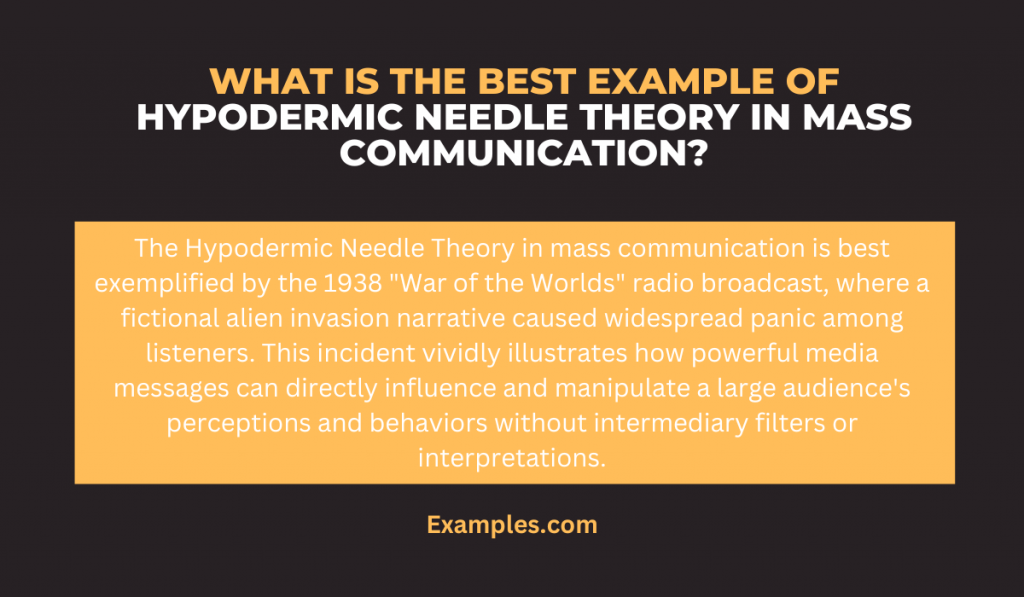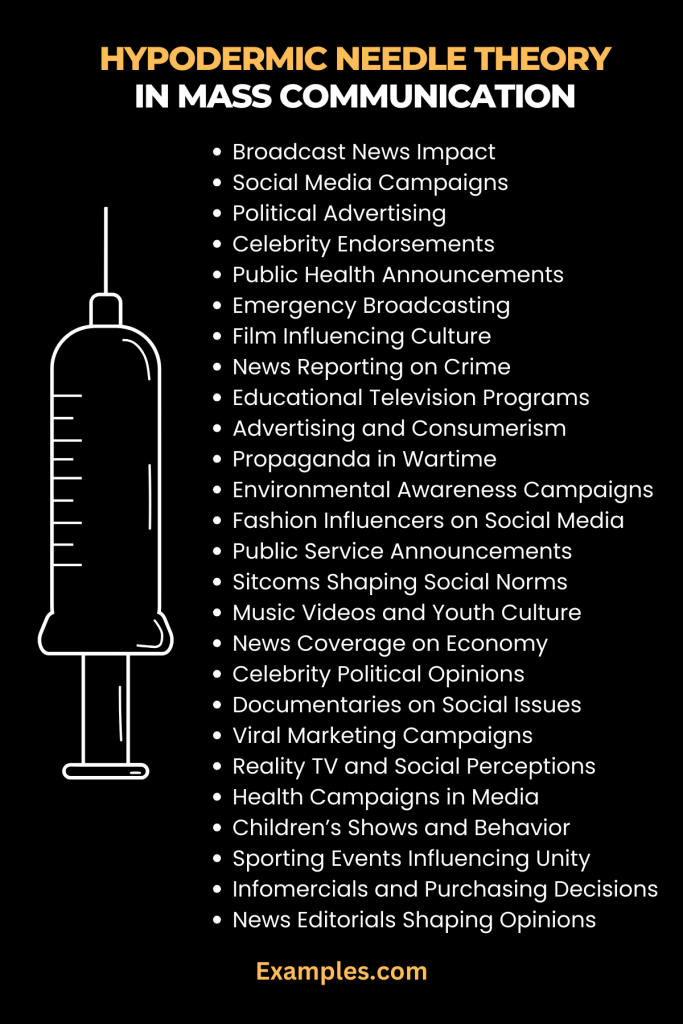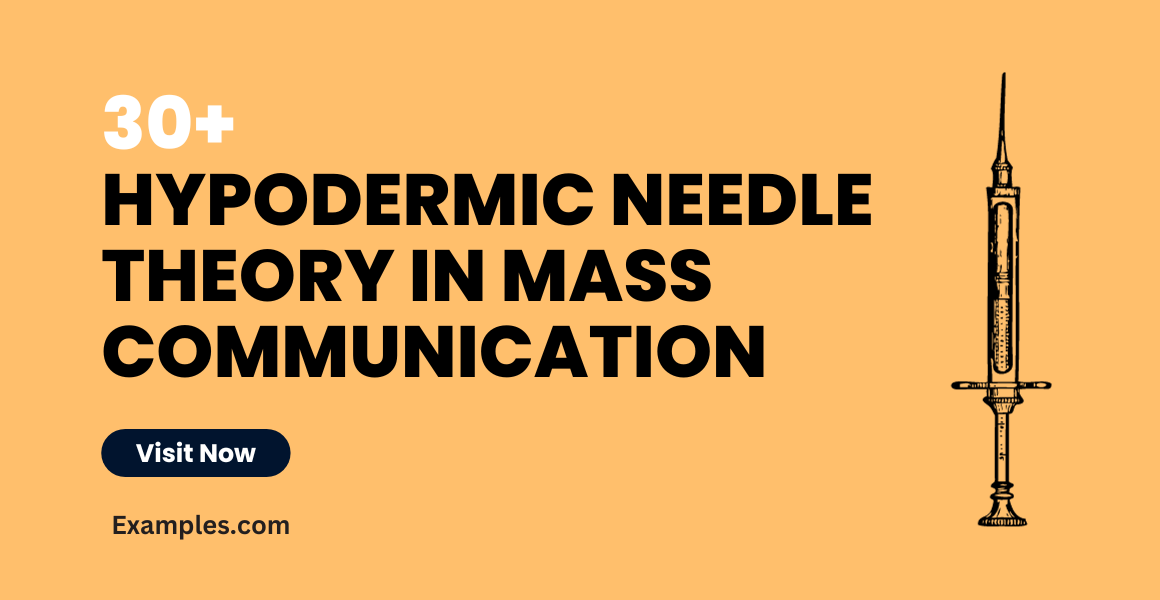29+ Hypodermic Needle Theory in Mass Communication Examples
Discover the intriguing world of Hypodermic Needle Theory in Mass Communication, a fundamental concept illustrating how media messages directly influence the audience. This complete guide delves into vivid Communication Examples and real-life applications, offering insights into the theory’s impact in various media forms, from Television Mass Communication to digital platforms. Understand how this theory plays a pivotal role in shaping public opinion and behavior in the realm of mass communication.
What is Hypodermic Needle Theory in Mass Communication?
The Hypodermic Needle Theory, a concept in Mass Communication Theories, offers a straightforward view on how media messages impact the audience. It suggests that media has a direct, immediate, and powerful effect on viewers, akin to a needle injecting substances into a body. This theory implies that media messages are “injected” directly into the minds of a passive audience, potentially influencing their behavior and opinions. It is particularly significant in understanding the effects of Broadcasting Mass Communication and other media forms, where messages are disseminated to a broad audience without much direct interaction.

History
The Hypodermic Needle Theory, also known as the Magic Bullet Theory, emerged in the 1920s and 1930s, a pivotal era in mass communication. This period saw the rapid rise of radio and film, leading to concerns about their powerful influence on the public. The theory was based on the idea that mass media could directly influence and control the masses. It gained prominence from the observation of propaganda’s effect during World War I and the rise of totalitarian regimes. However, as the field of mass communication evolved, this theory was critiqued for oversimplifying how people interact with media, leading to the development of more nuanced theories like the Two-Step Flow and Uses and Gratifications Theory.
What is the Best Example of Hypodermic Needle Theory in Mass Communication
The Hypodermic Needle Theory, a significant concept in Mass Communication Theories, illustrates how mass media can influence a large audience directly and uniformly. This theory likens the media’s influence to a hypodermic needle, suggesting that messages are “injected” directly into the passive audience’s minds, resulting in a uniform thinking and response.
A classic example of this theory in action is the 1938 radio broadcast of “The War of the Worlds” by Orson Welles. This event is often cited in Mass Communication Examples. The broadcast, which was a dramatization of a Martian invasion, caused widespread panic among listeners who believed the fictional news report to be real. This incident showcases how powerful media messages can be in shaping public perception and reaction, especially when the audience is not critically evaluating the content.
This theory underscores the significant impact of media on the public, highlighting the importance of understanding media influence in various Mass Communication Scenarios/Situations.

30 Hypodermic Needle Theory in Mass Communication
This theory, pivotal in Mass Communication Theories, suggests a direct influence of media messages on audiences. It highlights the power of Broadcasting Mass Communication and other forms, portraying media as a potent force in shaping public opinion and behavior. Here are 30 unique examples, each with a brief explanation:

- Broadcast News Impact: “The national broadcast swiftly changed public opinion about the policy.”
- Demonstrates the direct influence of news on public perception.
- Social Media Campaigns: “Social media campaigns on health awareness led to increased public health consciousness.”
- Shows the power of social media in altering health behaviors.
- Political Advertising: “The political ad campaign significantly swayed voters’ decisions.”
- Reflects the impact of advertising in shaping political views.
- Celebrity Endorsements: “Celebrity endorsements of products boosted sales dramatically.”
- Illustrates the influence of celebrities in consumer behavior.
- Public Health Announcements: “Public health announcements led to a rise in vaccination rates.”
- Exhibits the effectiveness of public announcements in healthcare actions.
- Emergency Broadcasting: “Emergency broadcasts during crises ensured widespread public safety measures.”
- Shows the role of broadcasting in disseminating critical information.
- Film Influencing Culture: “The blockbuster movie set new fashion trends.”
- Indicates the influence of film on cultural trends.
- News Reporting on Crime: “Intense news coverage of crimes heightened public fear.”
- Demonstrates the effect of news reporting on public emotions.
- Educational Television Programs: “Educational shows improved literacy among children.”
- Shows the direct educational impact of television programming.
- Advertising and Consumerism: “Aggressive advertising campaigns led to increased consumer spending.”
- Illustrates the role of advertising in consumer behavior.
- Propaganda in Wartime: “Wartime propaganda significantly boosted national morale.”
- Reflects the powerful role of media in shaping national sentiment.
- Environmental Awareness Campaigns: “Media campaigns increased public involvement in environmental conservation.”
- Shows the influence of media on environmental awareness.
- Fashion Influencers on Social Media: “Influencers on social media set new beauty standards.”
- Indicates the power of social influencers in setting trends.
- Public Service Announcements: “PSAs effectively spread awareness about road safety.”
- Exhibits the direct impact of PSAs on public behavior.
- Sitcoms Shaping Social Norms: “Popular sitcoms influenced public attitudes towards family dynamics.”
- Demonstrates the influence of television content on societal norms.
- Music Videos and Youth Culture: “Music videos became a fashion guide for the youth.”
- Reflects the influence of music media on youth culture.
- News Coverage on Economy: “News coverage on economic downturns affected consumer confidence.”
- Shows the impact of news media on economic perceptions.
- Celebrity Political Opinions: “A celebrity’s political stance influenced their followers’ voting behavior.”
- Illustrates the influence of celebrity opinions in politics.
- Documentaries on Social Issues: “Documentaries about social issues sparked public debates.”
- Demonstrates the role of documentaries in raising social awareness.
- Viral Marketing Campaigns: “The viral marketing campaign led to a surge in product popularity.”
- Indicates the power of viral marketing in consumer interest.
- Reality TV and Social Perceptions: “Reality TV altered perceptions about relationships.”
- Shows the impact of reality television on social perceptions.
- Health Campaigns in Media: “Media health campaigns increased awareness about mental health.”
- Highlights the influence of media campaigns on health awareness.
- Children’s Shows and Behavior: “Children’s shows promoted positive behavior among young viewers.”
- Demonstrates the direct influence of children’s programming on behavior.
- Sporting Events Influencing Unity: “Major sporting events fostered a sense of national unity.”
- Reflects the role of sports media in influencing national sentiment.
- Infomercials and Purchasing Decisions: “Infomercials significantly boosted the sales of home products.”
- Shows the impact of direct marketing on consumer decisions.
- News Editorials Shaping Opinions: “Editorials in leading newspapers swayed public opinion on policy matters.”
- Indicates the influence of journalistic opinions on public perspectives.
- Radio Talk Shows and Public Opinion: “Radio talk shows influenced listeners’ viewpoints on social issues.”
- Demonstrates the influence of radio media on public opinion.
- Billboard Advertising Impact: “Strategic billboard advertising led to increased brand recognition.”
- Shows the effect of outdoor advertising on brand awareness.
- Digital Media and Lifestyle Changes: “Digital media platforms introduced new lifestyle trends.”
- Reflects the impact of digital media on lifestyle choices.
- Media Coverage of Scientific Discoveries: “Media coverage on scientific breakthroughs increased public interest in science.”
- Highlights the role of media in spreading scientific knowledge.
Role of Hypodermic Needle Theory in Mass Communication
The Hypodermic Needle Theory, a pivotal concept in mass communication, posits that media messages are directly and uniformly injected into the passive minds of a mass audience. This theory, conceptualized in the 1920s and 1930s, underscores the powerful influence of media on public opinion and behavior. It has been instrumental in understanding the impact of mass media messages in various contexts, from public relations mass communication to broadcasting mass communication.
Understanding the Hypodermic Needle Theory
At its core, the Hypodermic Needle Theory is based on the idea that mass media has a direct, immediate, and powerful impact on its audience. The theory likens the media’s influence to a hypodermic needle injecting ideas or messages into a passive audience. This model assumes that audiences are homogenous and uncritical, implying that media messages are accepted and wholly believed by the masses without question.
Application in Modern Mass Communication
In contemporary mass communication, the relevance of the Hypodermic Needle Theory can be seen in various fields like television mass communication and social media mass communication. The theory aids in understanding how propaganda and advertising campaigns can shape public opinion and behavior. Although the audience today is considered more active and diverse, the basic premise of this theory helps in strategizing mass media campaigns for uniform impact.
Critiques and Evolution
While the Hypodermic Needle Theory has been foundational in mass communication studies, it has faced criticism for oversimplifying the relationship between media and its audience. Critics argue that this model fails to consider audience diversity and the selective nature of media consumption. Over time, this has led to the development of more nuanced theories that recognize the active role of audiences in interpreting media messages.
Relevance in the Digital Age
In the digital era, the Hypodermic Needle Theory’s concept still finds relevance, especially in understanding the impact of viral content and online propaganda. With the advent of digital platforms and mass communication examples in a digital age, this theory provides a framework to analyze how information can spread rapidly and influence a wide audience.
Importance of Hypodermic Needle Theory in Mass Communication
The Hypodermic Needle Theory, also known as the “Magic Bullet Theory,” plays a pivotal role in the study of mass communication. This theory posits that mass media messages are injected directly and uniformly into the minds of a passive audience. This concept is particularly significant in understanding the impact and power of mass media on public opinion and behavior.
In the context of mass communication, the Hypodermic Needle Theory underscores the direct and sometimes unmediated effect of mass media messages on the audience. This theory is a cornerstone in the study of media effects, paving the way for subsequent theories and models that seek to explain how and why media influences its audience.
Understanding the Direct Influence
The Hypodermic Needle Theory suggests that media has the power to inject ideas and messages directly into the passive minds of the audience. This model was particularly relevant in the early days of mass media, where media channels like radio and newspapers were few, and their reach was wide and uniform. In such a scenario, messages broadcasted or published were believed to have a direct, immediate, and powerful impact on the general public. This theory is often linked with significant historical events where media played a crucial role in shaping public opinion.
Media’s Role in Shaping Public Perception
According to this theory, mass media has the potential to shape and mold public opinion. This concept is especially important in Public Relations Mass Communication and Broadcasting Mass Communication, where the goal is often to influence public perception and behavior. The Hypodermic Needle Theory highlights the importance of crafting media messages carefully, as they could have a widespread and instantaneous effect on the audience.
Critical Analysis and Modern Perspective
While the Hypodermic Needle Theory was influential in the early understanding of media effects, modern perspectives have critiqued its oversimplification of the communication process. In contemporary settings, audiences are no longer seen as passive recipients of media messages. Instead, they are considered active participants who interpret and filter information based on their individual backgrounds, experiences, and biases.
How to Use Hypodermic Needle Theory in Mass Communication
The Hypodermic Needle Theory, a pivotal concept in mass communication, suggests a direct and powerful impact of media messages on the audience. Understanding and applying this theory in various mass communication contexts, from Public Relations Mass Communication to Broadcasting Mass Communication, can be highly beneficial. Here’s a comprehensive guide on effectively using the Hypodermic Needle Theory in mass communication.
Understanding the Core Concept
Before applying the Hypodermic Needle Theory, it’s crucial to understand its fundamentals. This theory posits that media messages are injected directly and uniformly into the minds of a passive audience. This leads to a direct and immediate response, highlighting the potent influence of mass media.
Application in Public Relations and Advertising
In Public Relations Mass Communication and advertising, the Hypodermic Needle Theory can guide how messages are crafted and delivered. PR campaigns and advertisements often aim for a strong, immediate impact, mirroring the theory’s principles. By creating compelling, direct messages, practitioners can elicit quick reactions and shape public opinion effectively.
Use in Broadcasting and Journalism
Broadcasting and journalism are other key areas where this theory finds relevance. News outlets, following the Hypodermic Needle Theory, can construct news stories that are intended to shape audience perceptions swiftly. This approach is particularly significant in crisis communication, where quick, influential messaging is necessary.
Digital Media and Social Media Implications
In the age of digital and Social Media Mass Communication, the Hypodermic Needle Theory takes on new dimensions. Social media platforms, with their vast reach and immediacy, can serve as perfect conduits for the rapid dissemination of information, aligning with the theory’s concept of immediate influence.
Educational Applications
This theory can also be employed in educational settings, like in Mass Communication Examples in School. Educators can use the theory to design curriculum and teaching methods that ensure immediate and impactful learning through media.
Critique and Modern Adaptation
While the Hypodermic Needle Theory has been critiqued for oversimplifying audience reception, understanding these criticisms is key to its modern adaptation. It’s important to recognize that contemporary audiences are more active and discerning, necessitating a nuanced application of the theory.
The Hypodermic Needle Theory in mass communication reveals the profound impact of media on audiences. It exemplifies the Uses & Benefits of Mass Communication, emphasizing how messages can influence public opinion and behavior. This theory, a cornerstone in understanding media effects, remains a vital concept for students and professionals in the realm of mass communication.



